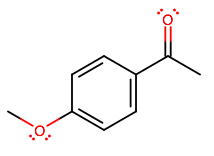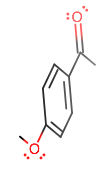Nitration of the aromatic ring of 4-methoxyacetophenone yields only one product. What is that product and how can you account for its formation?
1 Answer
This is a lab question, no?
Anyways, notice how the molecule is symmetrical (it lies on a single plane).

Try rotating the molecule in your head, and then placing the molecule on a plane (of reflection symmetry).

Then try rotating it
Next, your book should tell you that:
- The acetyl group is a decent electron-withdrawing group, so is a moderately deactivating substituent. That means it is a meta director to incoming substituents like the nitro group you're apparently adding.
- The methoxy group (an ether group when attached onto benzene) is a good electron-donating group and is consequently a strongly activating substituent. That makes it either an ortho or para director. It can't direct para because it's an occupied position, so it must direct ortho.
Is that enough for you to determine why there is only one product? You would have to further explain why the combination of the meta directing substituent, the ortho directing substituent, and the symmetry of the molecule dictates only one possible product.
Can you identify this product?
- What is the target position of the nitro group as a result?
- Does it matter which side of the
#C_1-C_4# axis it binds to?

